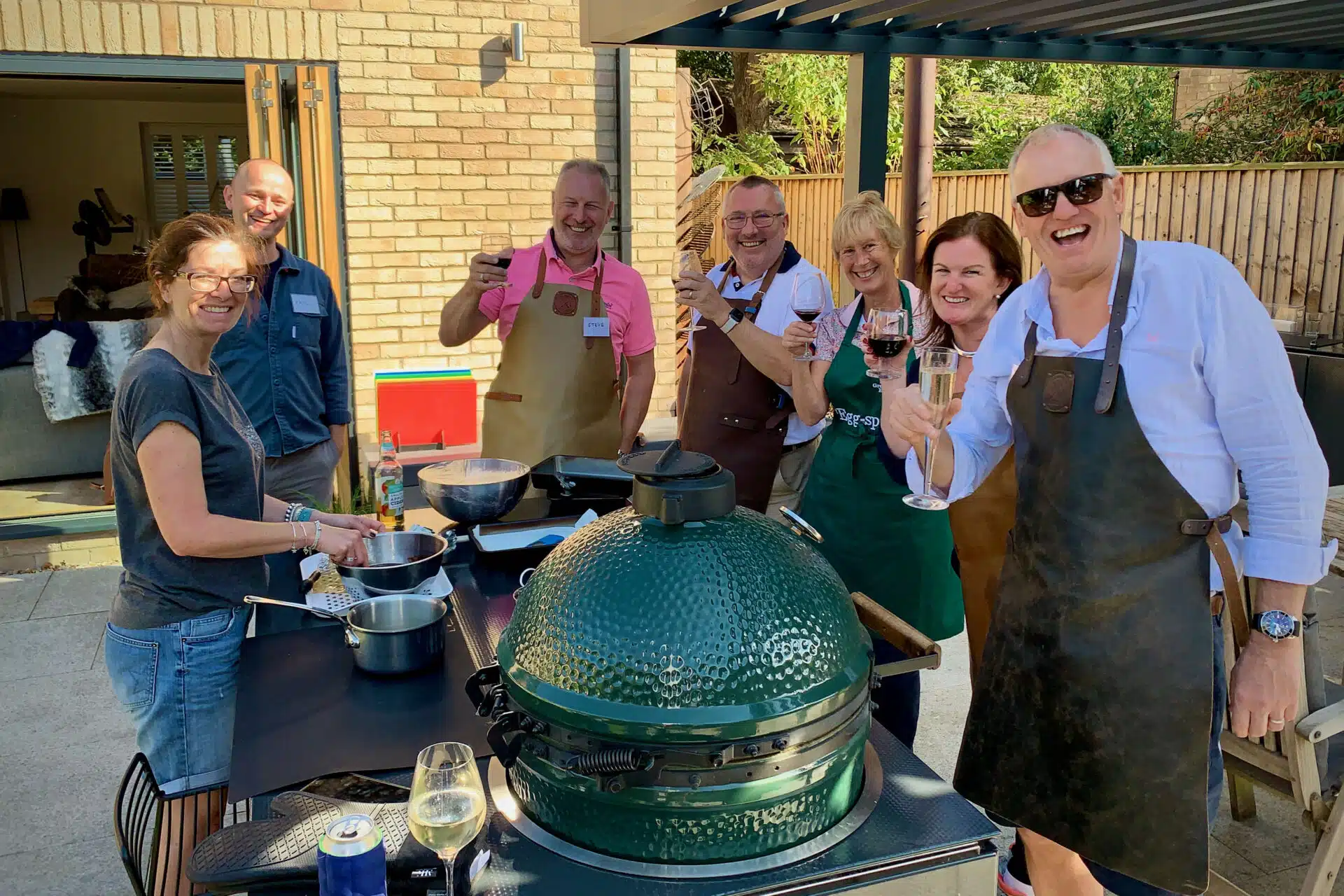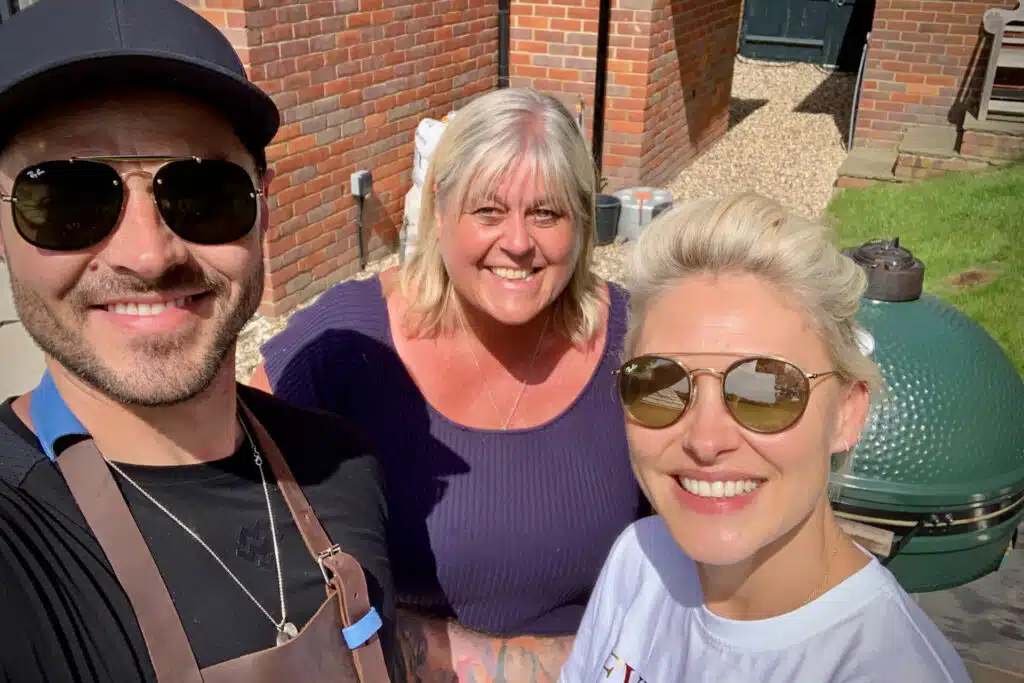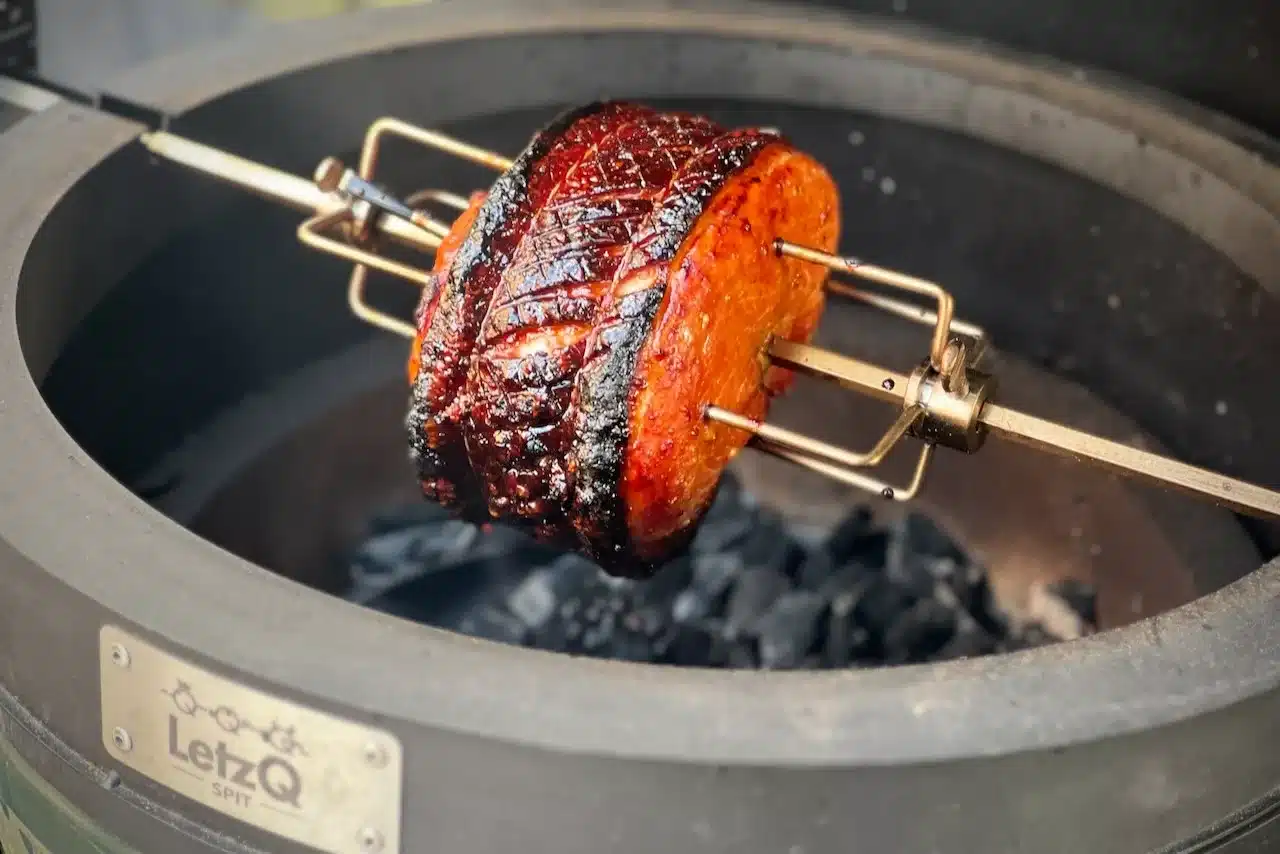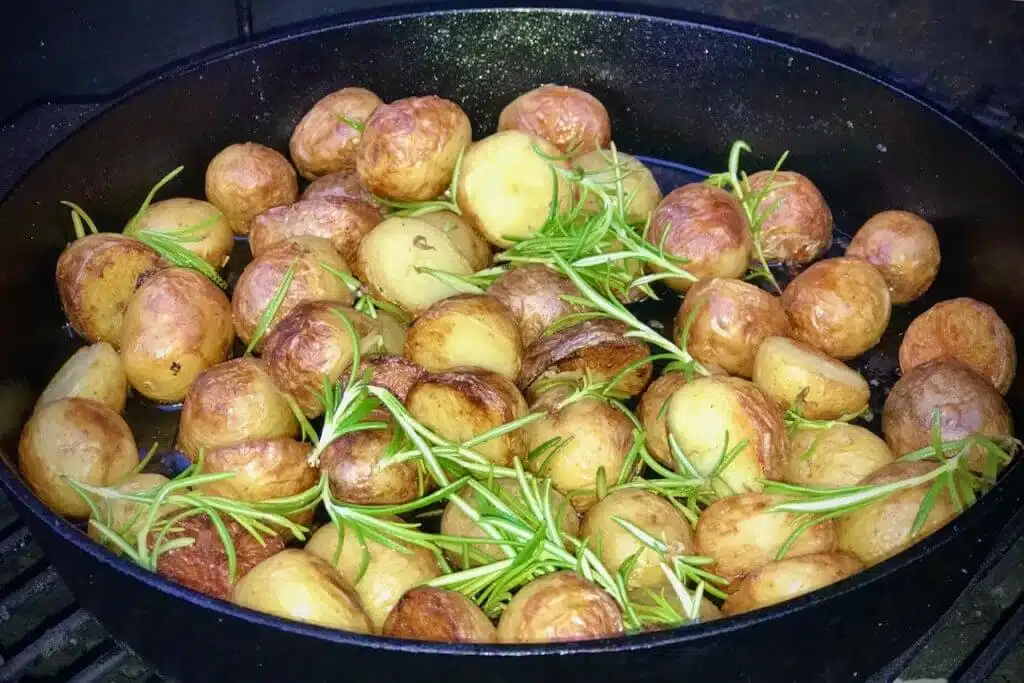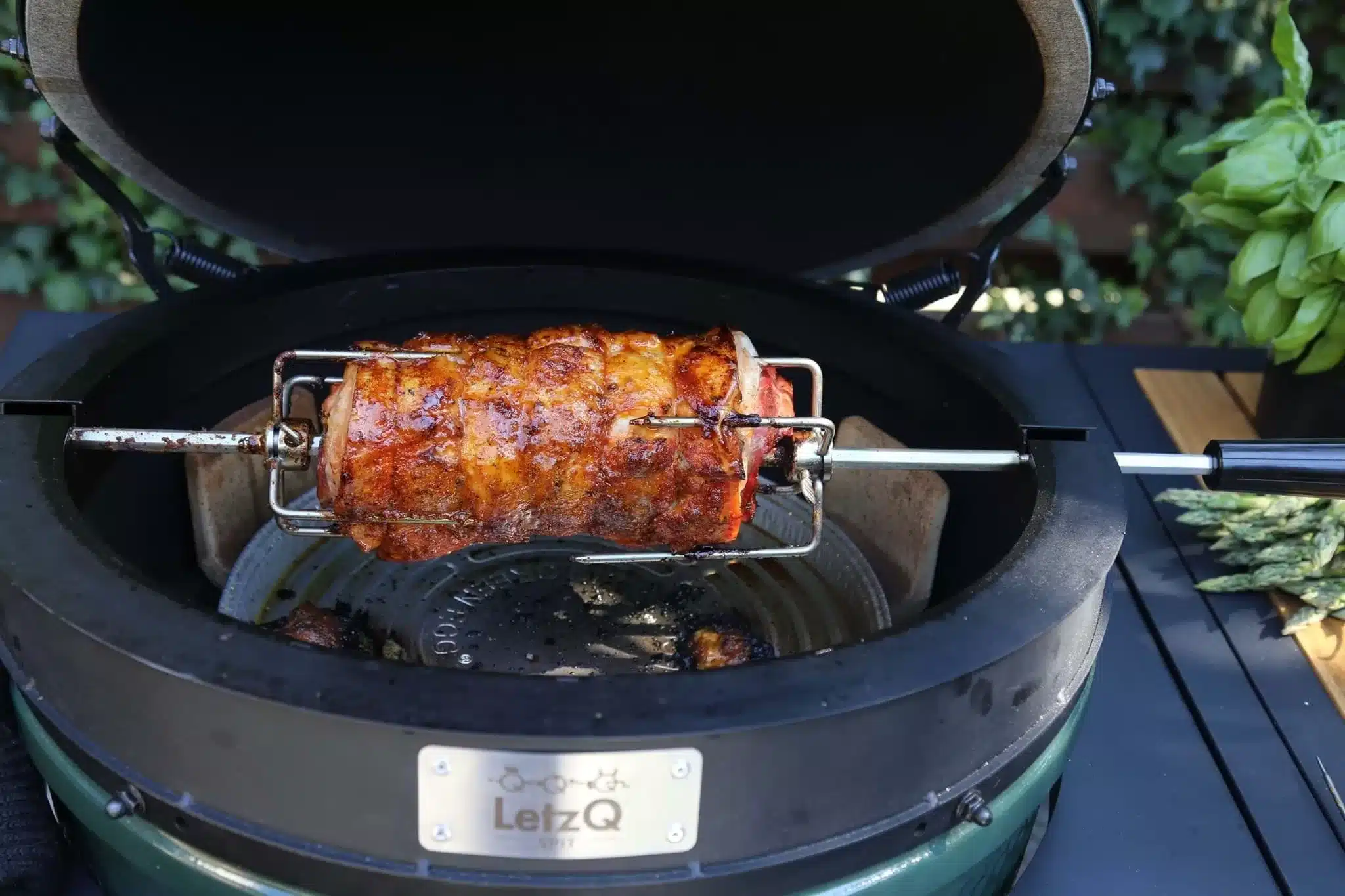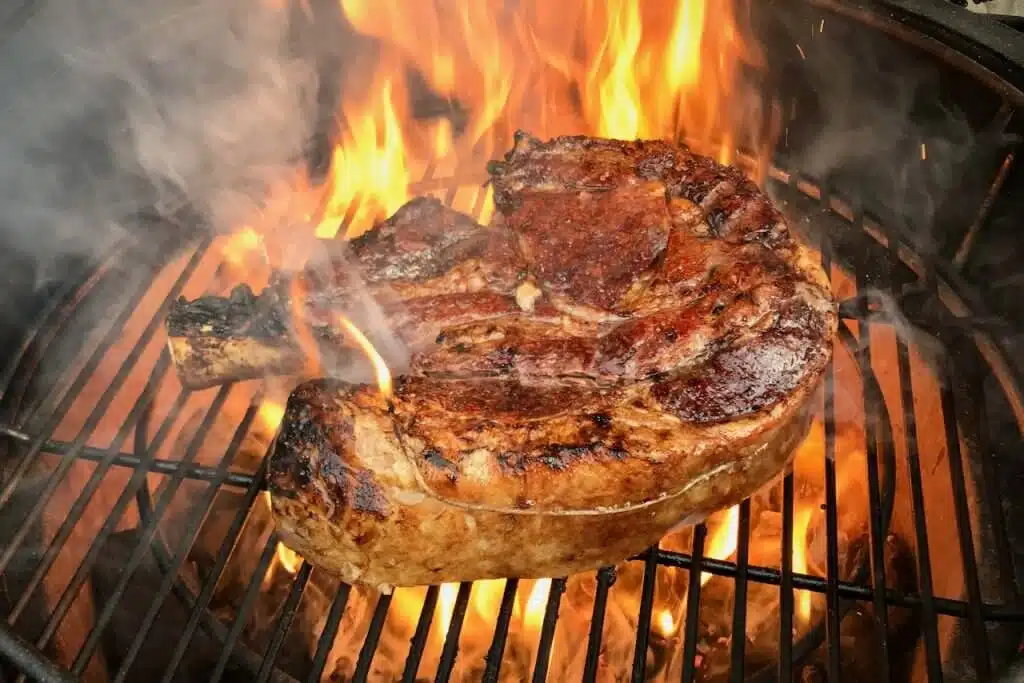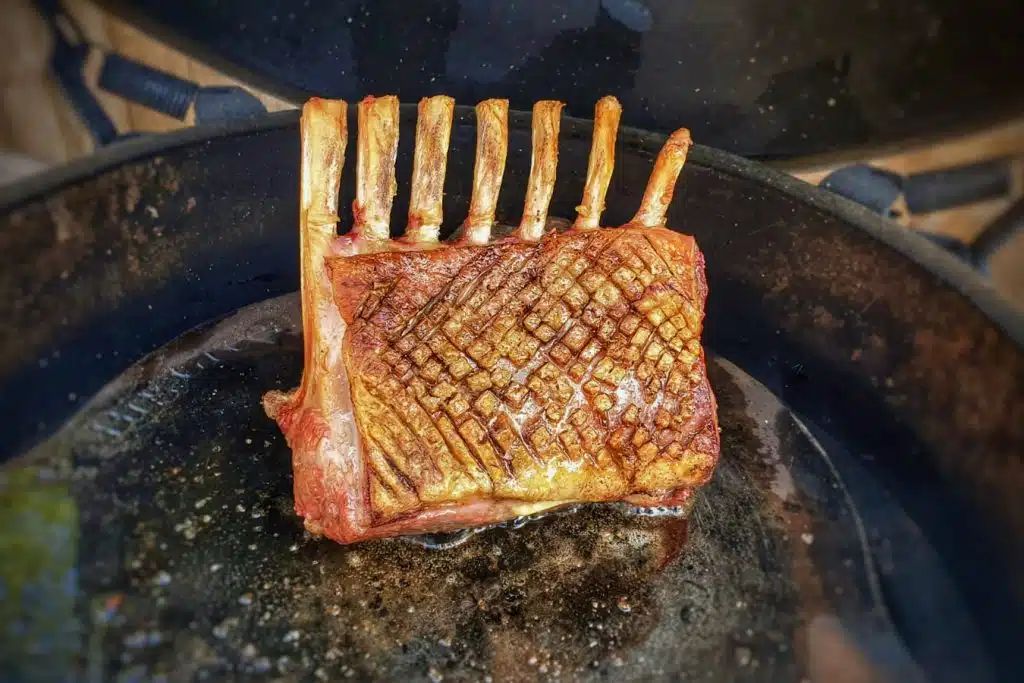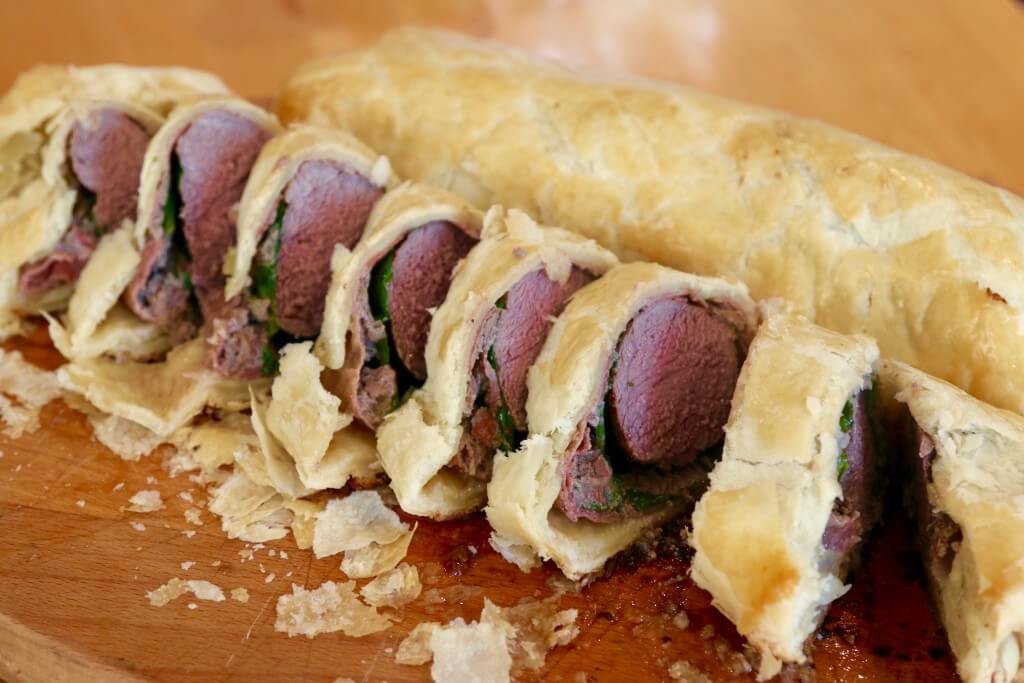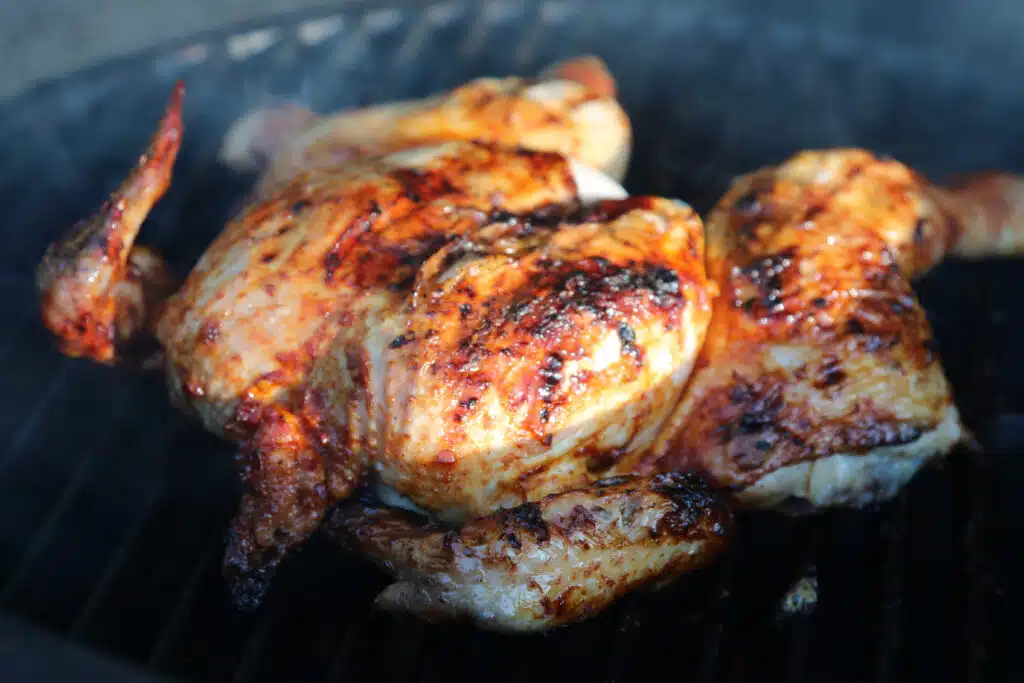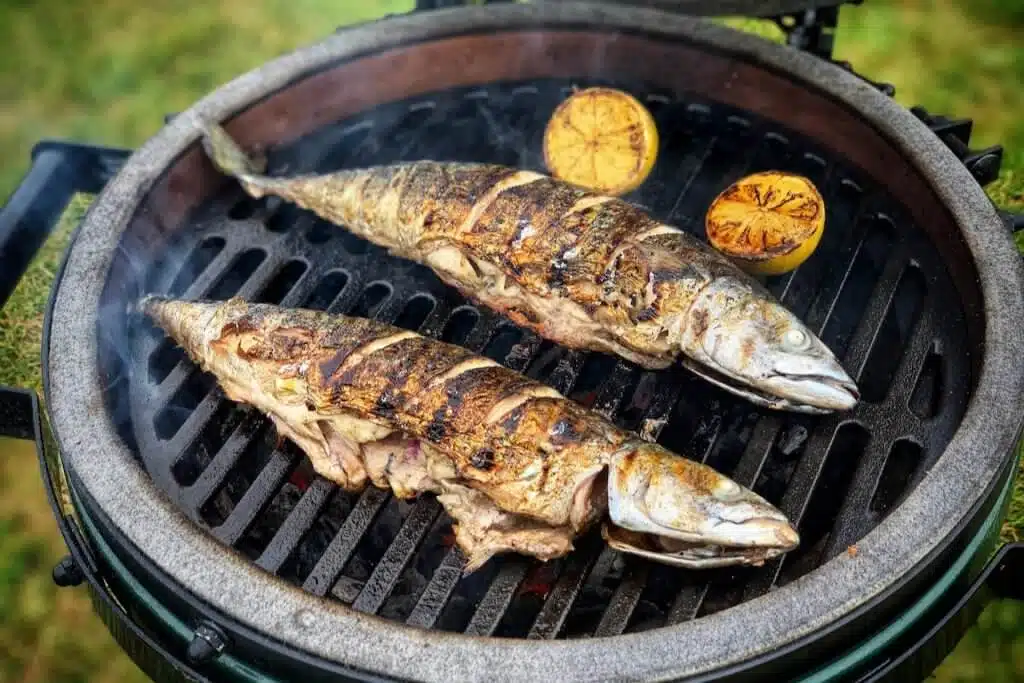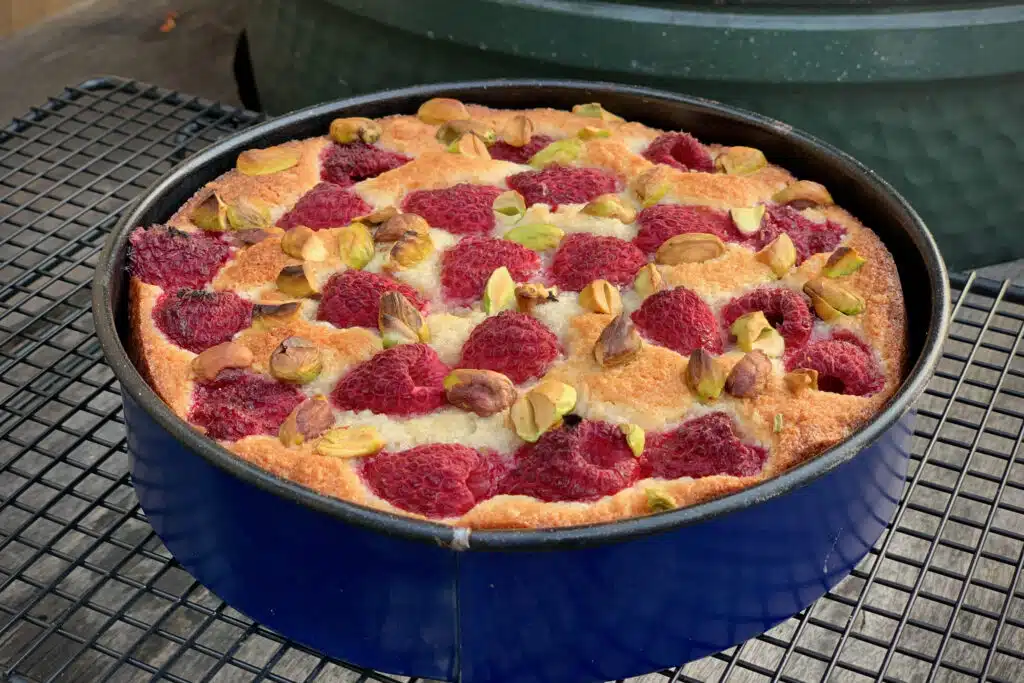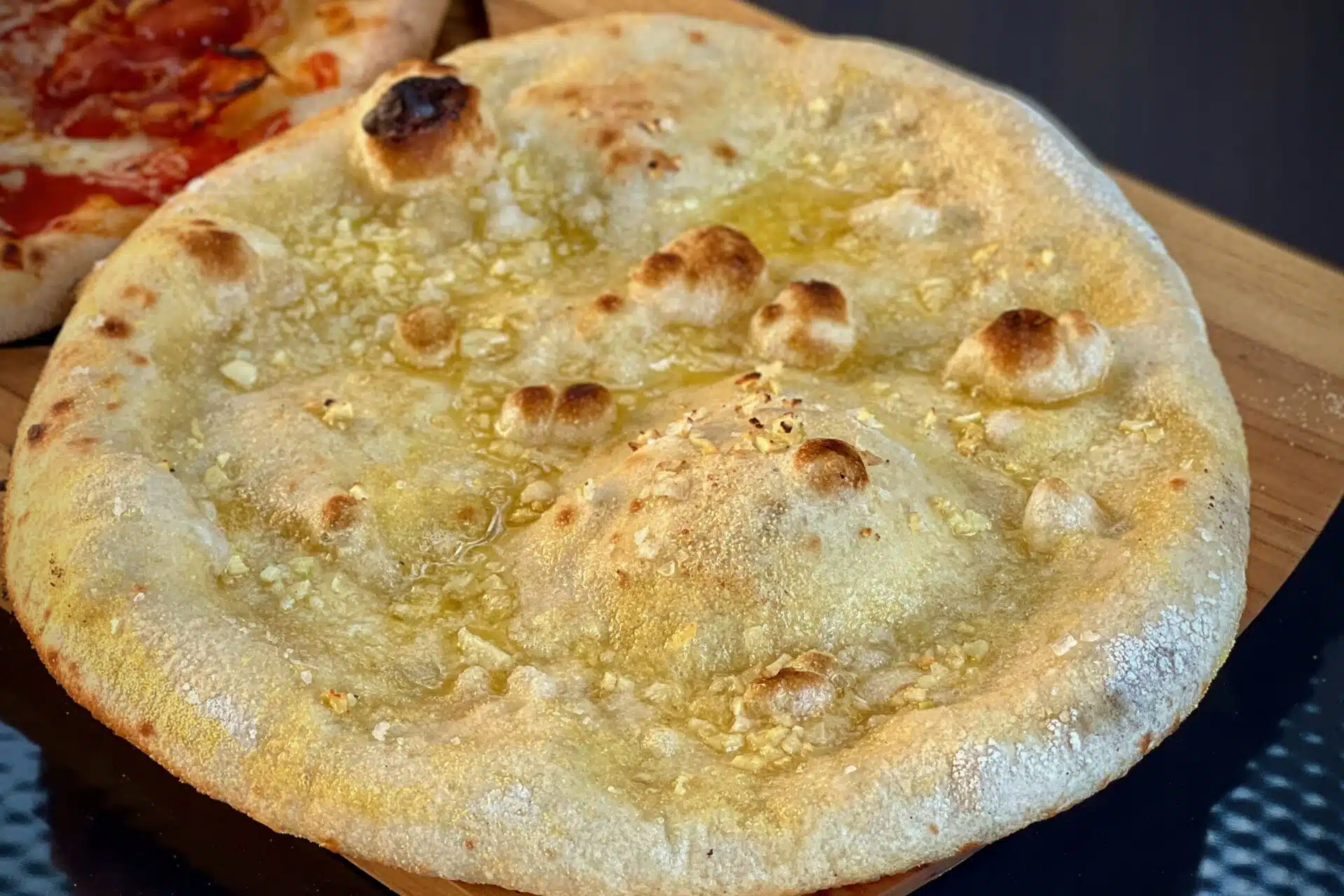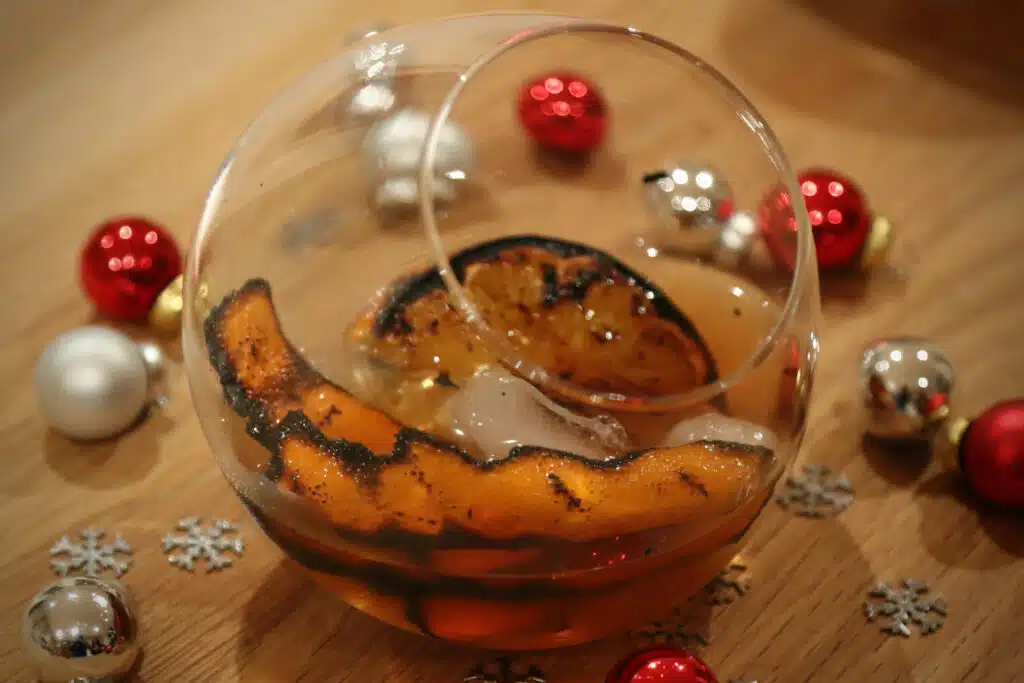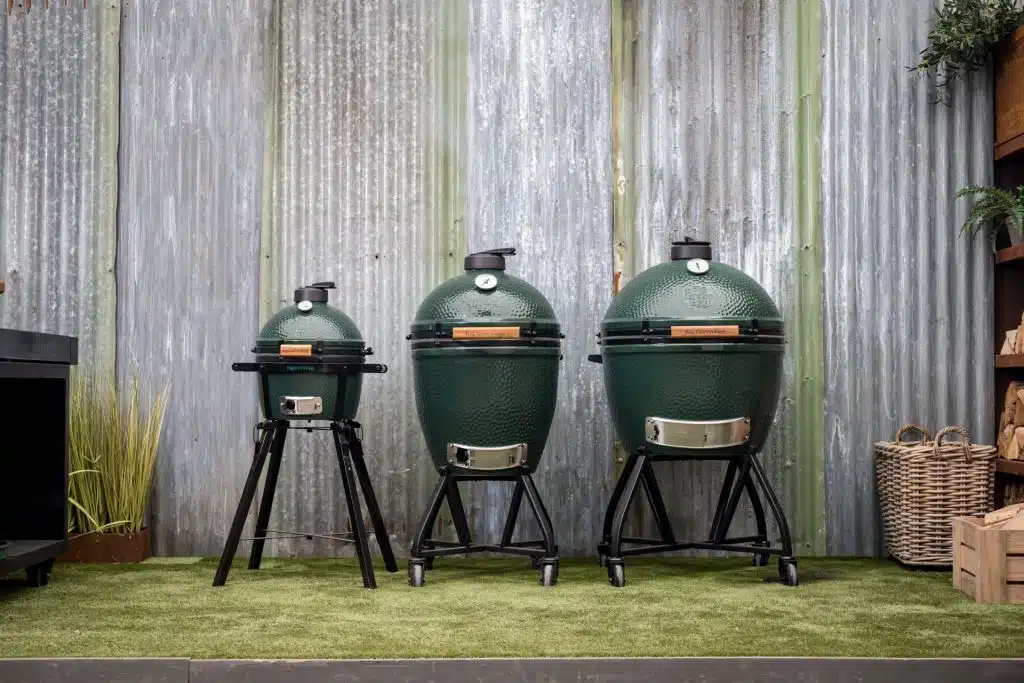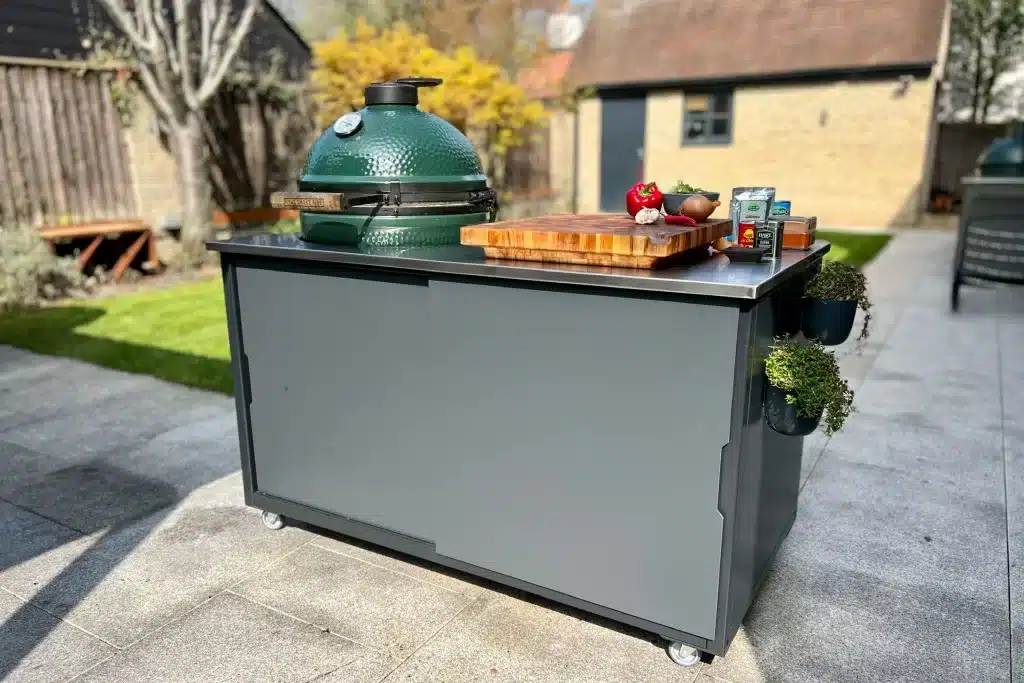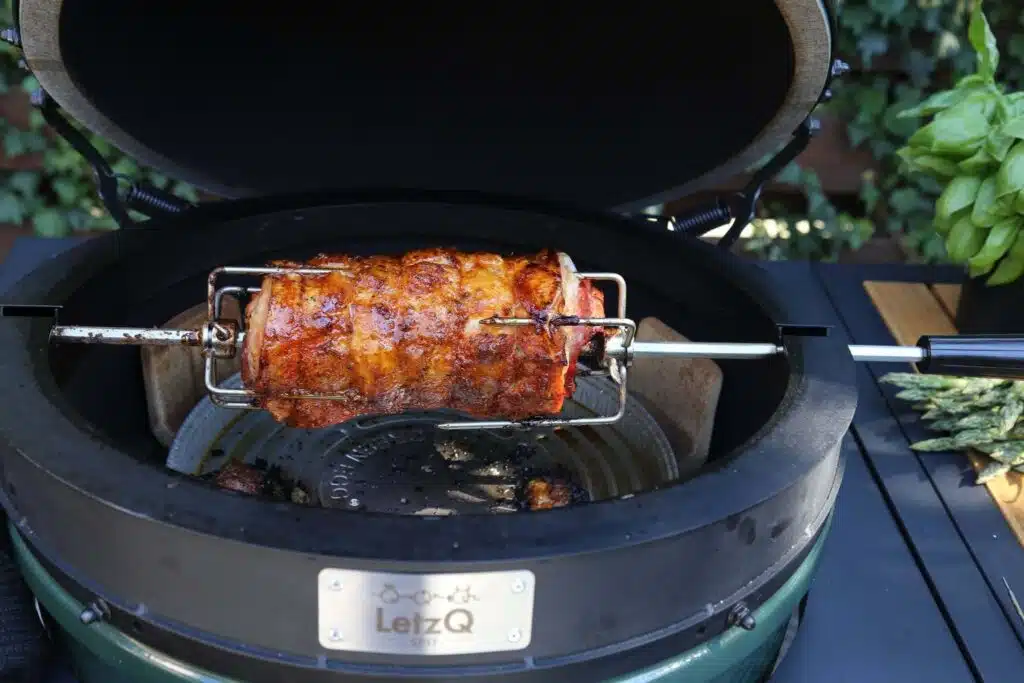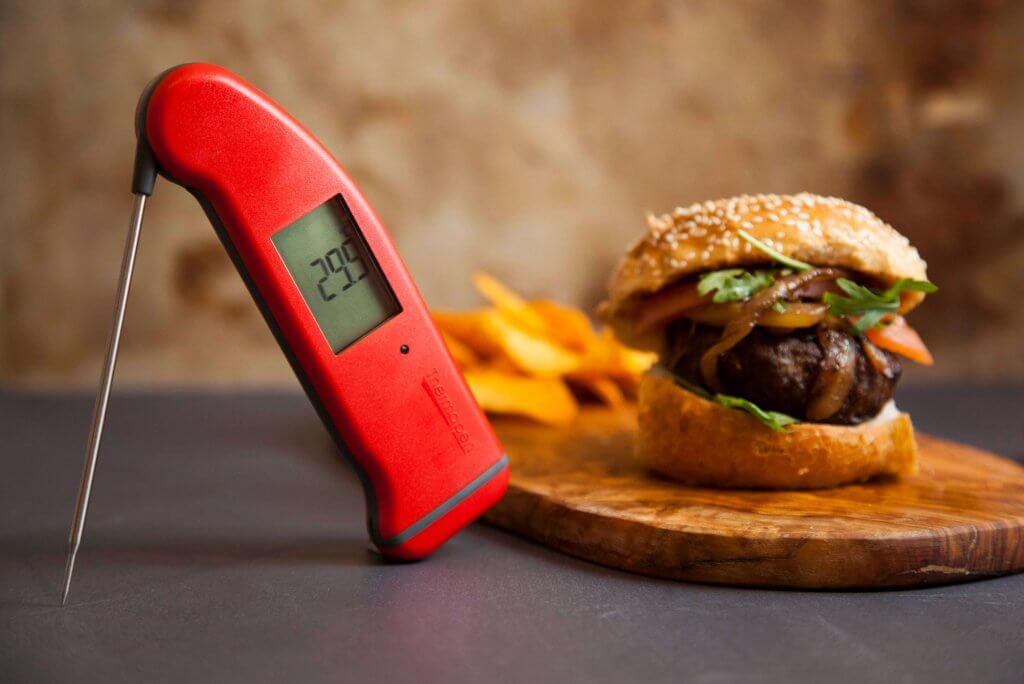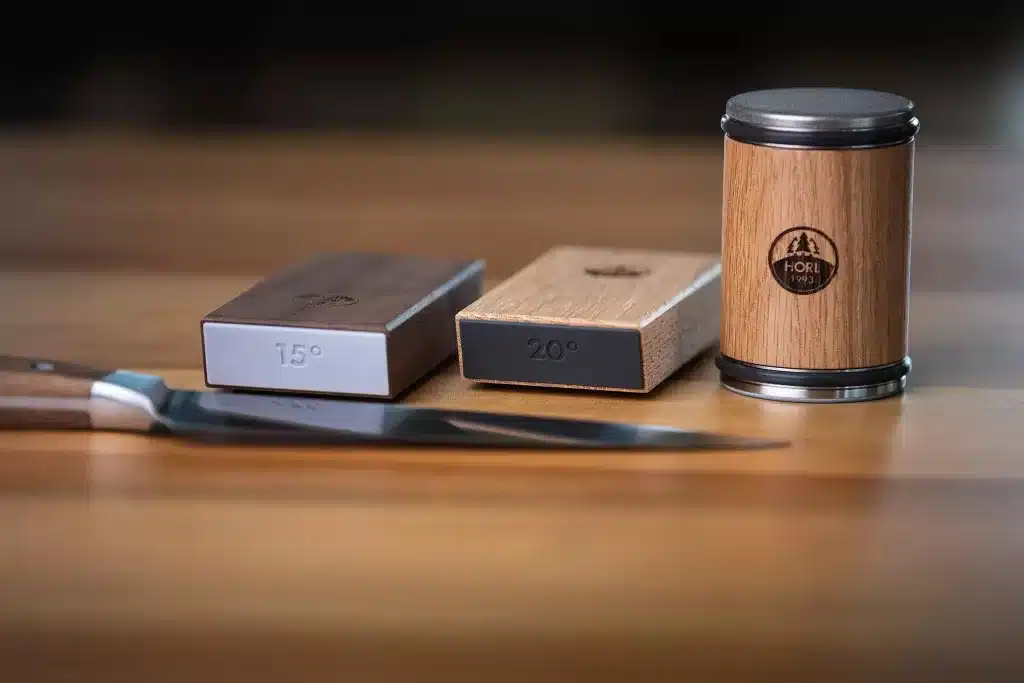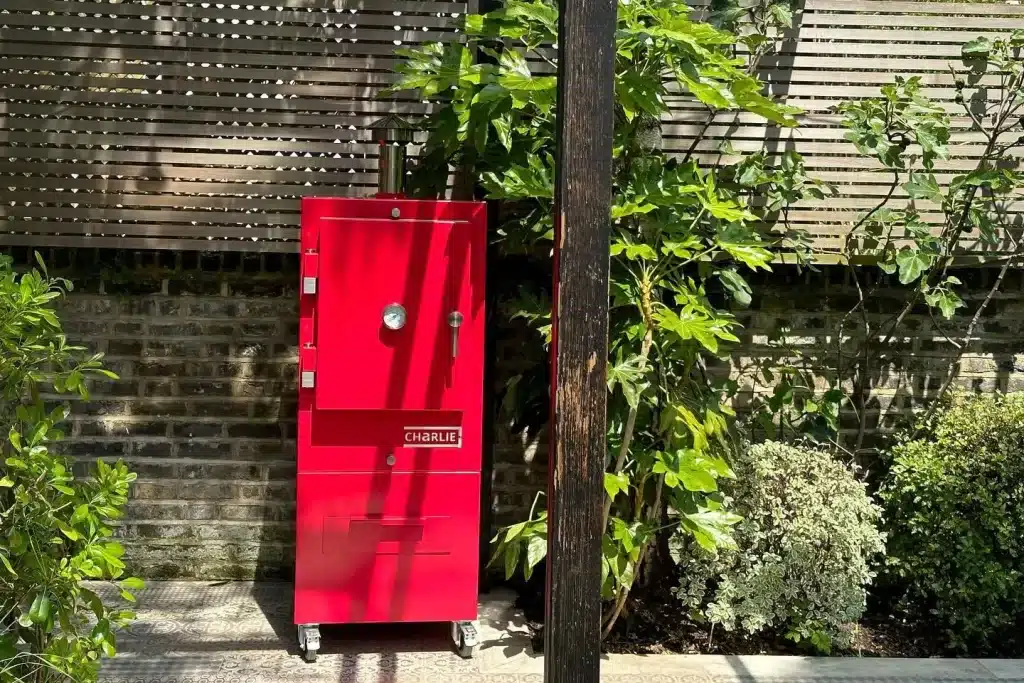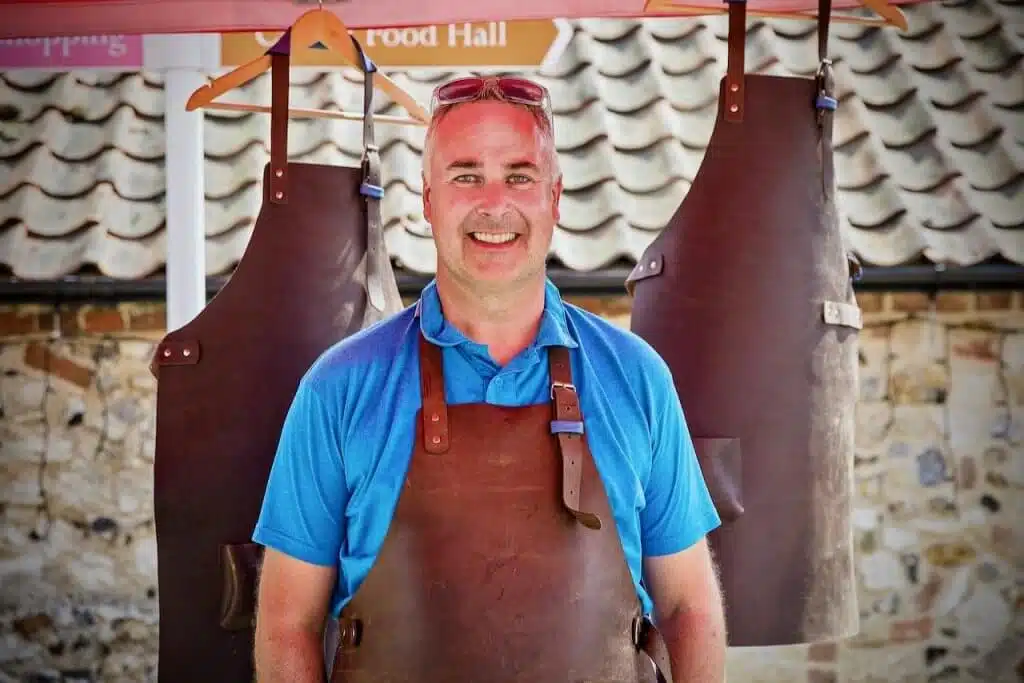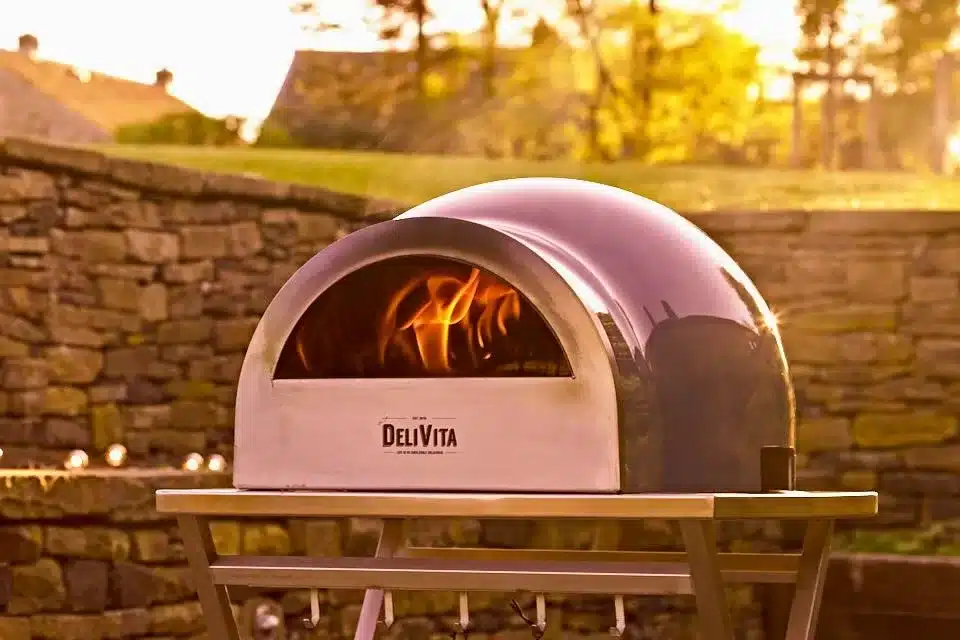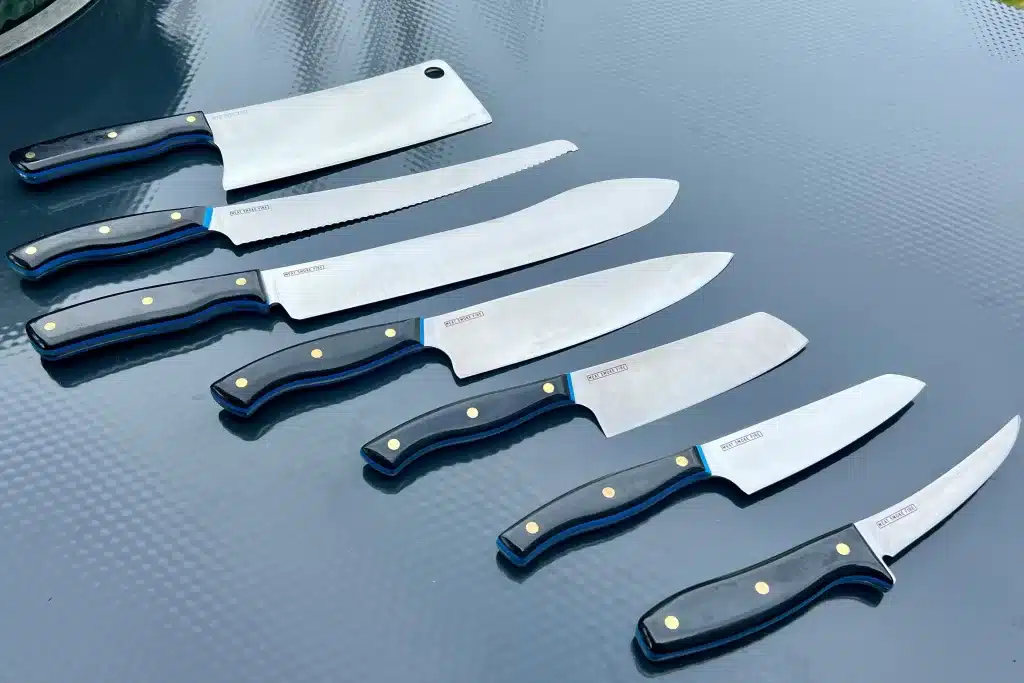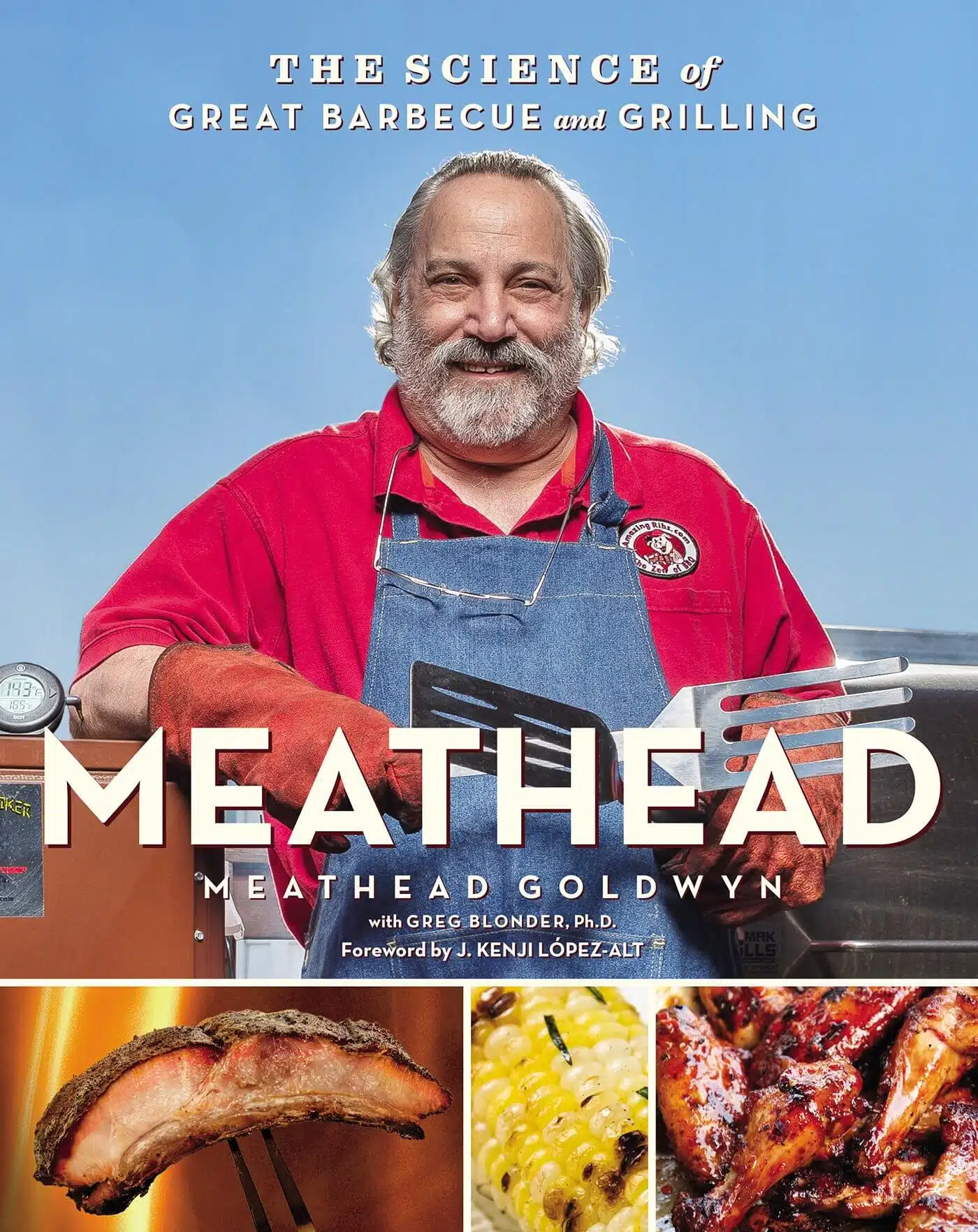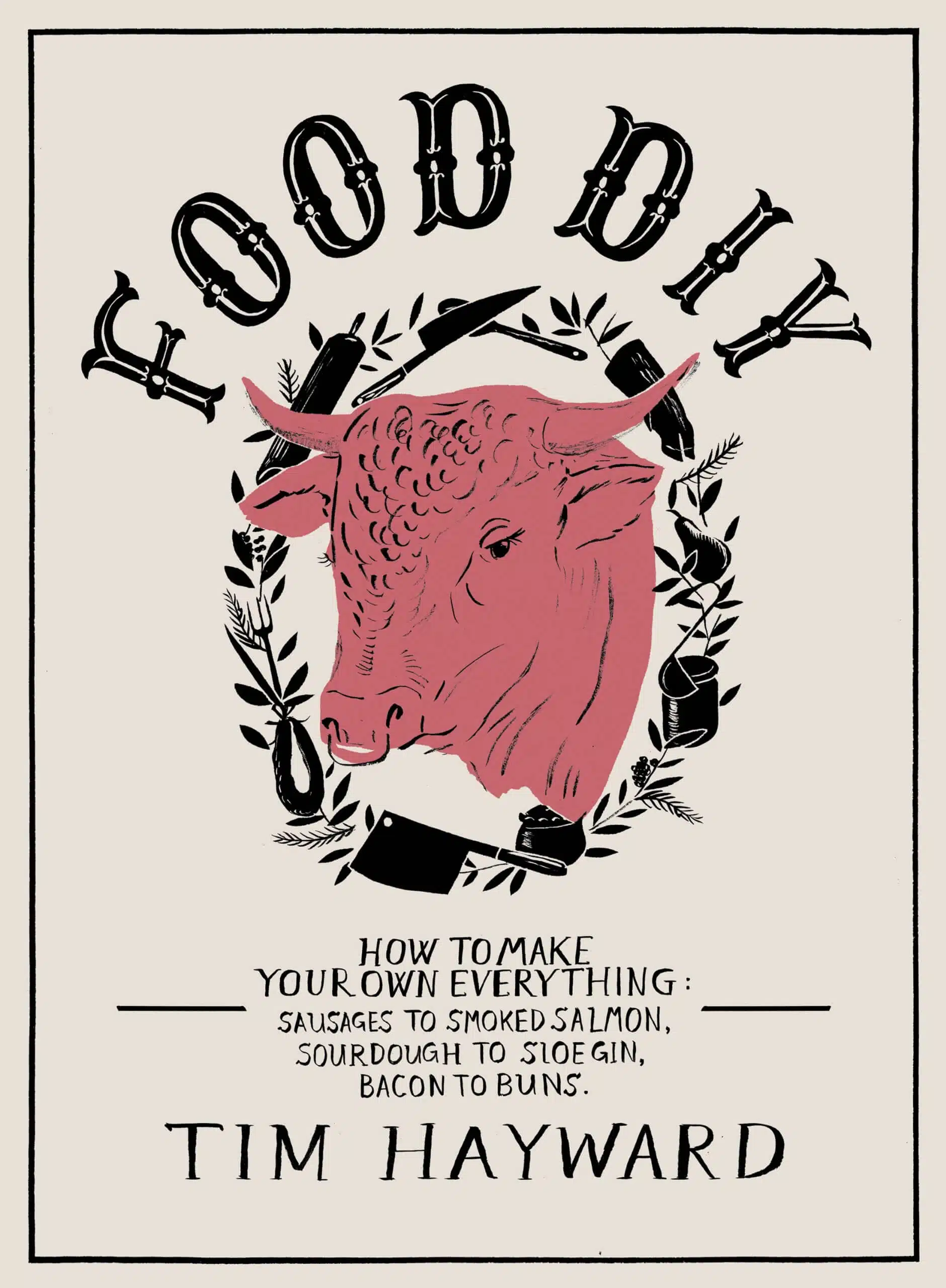


Recipes
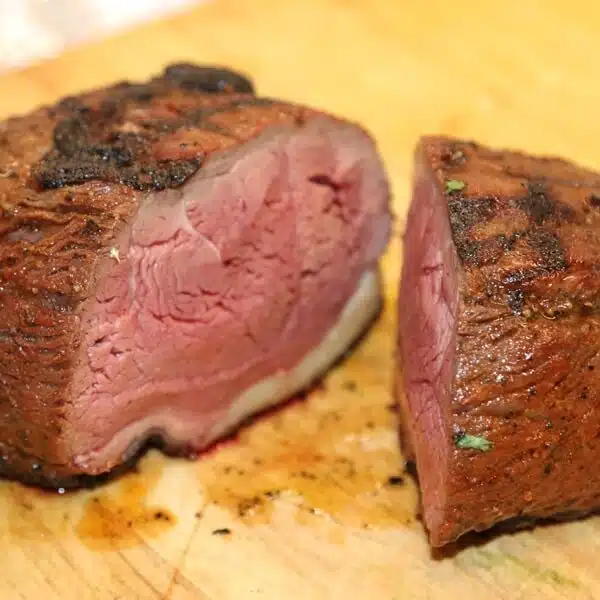
Picanha
The technique we used here was a reverse sear where we slowly raised the temperature of the whole piece of meat by cooking it at 110°C until it’s internal temperature was 53°C (5°C below medium rare). We then fired up the BBQ to about 250°C and seared the outside of the picanha before resting it for about 15 minutes and serving in slices.
The initial cook was indirect, we used the plate setter feet up with the stainless grid on top. To that we added the meat and cooked slowly until the core temperature reached 53°C (5°C lower than the temperature we were aiming for as the last 5°C would be achieved when we seared the meat).
We then removed the plate setter and opened the air vents to raise the temp to 250°C. We used the stainless steel grid to sear the Picanha for about 3 minutes on each side.
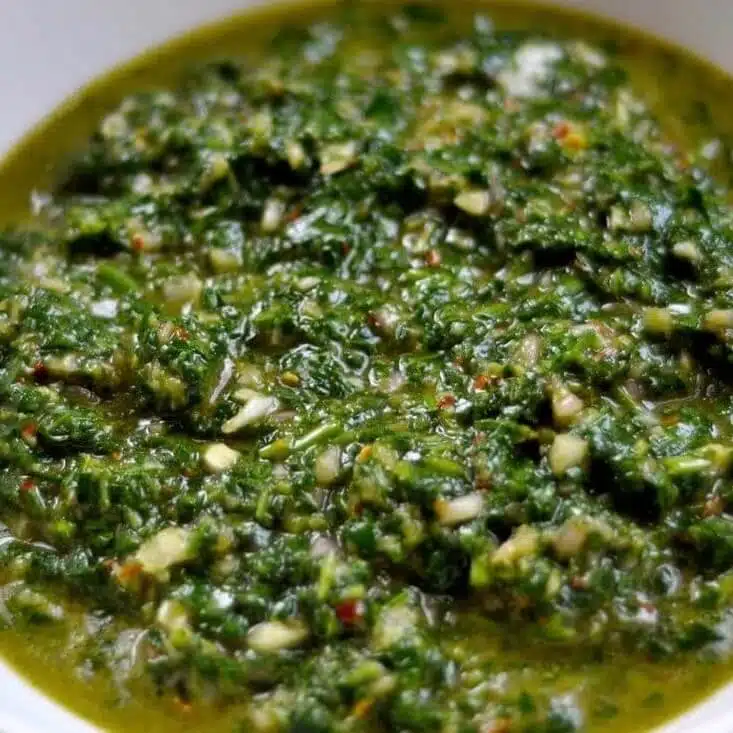
Chimichurri
We used a BBC Good Food recipe.
This was a quick and easy sauce to make to go with the Picanha.

Dirty Steak
Dirty steak is my favourite way of cooking steak in our house. Compared to Picanha though I think the consensus was that the Picanha was better.
Cooing the steak dirty adds a really meaty flavour to the steak. It’s also a little controversial when you have mates over. Very little ash sticks to the steak. I think it’s a great technique.
You can cook veg this way too. Daniel Clifford at Midsummer House in Cambridge cooks celariac and beetroot directly on the coal, it’s divine.

Lamb Rack, French Trimmed
This would be a great recipe to do with the cauliflower as it also can be cooked on the back of the plate setter (or a ceramic plancha).
Again we setup the Egg in an indirect configuration with the plate setter feet down. We set the temperature of the Egg to 180-200°C.
I scored the fat of the lamb rack in a diagonal pattern with the scoring about 3/4 cm apart. I then added a tiny bit of oil and generously seasoned the lamb with maldon salt.
I then cooked this directly on the plate setter, fat side down for about 15-18 minutes. At the last minute, we turned the lamb to add a little bit of sear to the edges.
I used a Themapen to probe the meat. For medium rare, we were looking for an internal temp of 58°C. The lamb will continue to cook while it’s resting so take it off about 3°C before (55°C for medium rare).
Always rest your meat wrapped in foil.

Roast Cauliflower with Truffle Oil and Black Sesame Dressing
The technique here was to cook on the back side of the plate setter. All I did was wipe down the back of the plate setter with a dry paper towel or foil.
We set up the Egg to cook at 180-200°C with the plate setter feet down.
I cut the cauliflower into about 7mm thick slices all the way through the cauliflower. I removed most of the really thick bit of stalk before cooking. I then added a touch of oil and some maldon salt to the slices (on both sides) and placed them directly onto the plate setter. We then cooked them for about 5 minutes on each side until they start to turn golden brown.
To this we added the dressing. A great addition is toasted black sesame seeds to give a little crunch.

Focaccia
This Italian bread is really simple to make and an easy first go at baking on the Egg.
Make a batch of my basic bread recipe and let it rise. Knock it back and split into two portions. Push out each of these dough balls into the bottom of a 30cm x 20cm baking pan, lightly oil the top and cover with cling film. Put to one side to allow it to rise again.
When ready poke it with your fingers to make the dimples. Drizzle generously with olive oil and sprinkle with salt and herbs (we used rosemary).
Setup your Egg for an indirect cook with the plate setter feet up, stainless steel grid on top and the baking/pizza stone on top of that. Get your Egg to 220°C and give the baking stone a while to heat up, probably 20 mins..
Cook your focaccia in the tin on the baking stone for about 15 minutes until it’s both golden brown on the top, but also crunchy on the bottom. Allow it to cool on a wire rack before serving.

Planked Salmon
The plank is designed to smoulder while the salmon roasts on top of it, taking on the wood flavour as it cooks.
Soak the planks in water for at least 1 hour before you use them. You can also soak them in other liquids such as:
- Beer, lager or cider.
- A dilution of citrus juice.
Get your Egg to 180°C in a direct setup with just the stainless or cast iron grids. Dry the side of the plank you will put the fish on, for about a minute, by placing it cooking side down on the Egg.
Take your salmon fillets and place them skin side down onto the plank. Use the grill gripper to move the plank onto the Egg. I put a slice of lemon onto the salmon to show the smoke, not to add flavour. It looks pretty though.
Cook until the salmon has firmed up enough to show it is cooked (about 8-10 mins). Take off the plank with the grill grippers and put onto something heat proof.

Flat Peach Tarte Tatin
This was our last cook of the day and the one you guys seemed to enjoy the most, loads of mmms.
We used one of the Tefal pans to make a caramel before addding the peaches, butter and pastry. The caramel was cooked direct on the MiniMax, we then baked it (indirect) on the Large Egg. You could always do the first stage on the hob inside.
Don’t stir the caramel, it’ll crystalise. Just leave it until the colour starts changing.
Be careful with the flip at the end, hot caramel burns. Make sure you’re not under pressure with a big audience :-).
Technique
What temperature should I cook at?
The following chart shows meat cooking temperatures depending on your cut of meat and your preferred level of cook:

Cooking temp guide from AmazingRibs.com
The Stall or Plateau explained
We talked about how the tougher cuts of meat will go into a stall at around 65°C when they are cooked. This is as the outer layers of the meat dry out and form a bark.
The best resource on this is at AmazingRibs.com. Give it and the other articles a read. It’s a superb site.
What settings are needed for specific temperatures?
Setting the temperature on your Egg will vary slightly from Egg to Egg. However for a large Big Green Egg the settings are roughly as per the guide I have put together.
Rest your meat
Always remember to rest your meat after cooking it. This give the structure time to relax and reabsorb moisture. It will make your meat taste far more tender and juicy.
There is a great article discussing whether this is a myth but I still like to rest my meat: http://amazingribs.com/tips_and_technique/mythbusting_resting_meat.html
Reverse Sear
When you do a reverse sear as we did for the Picanha, bring the temperature of the meat to 5°C less than you require it to be when finished. This is because the sear process will raise the temperature by another 5°C. For example, for a medium cooked steak you want it to be 63°C, therefore cook it until is has an internal temperature of 58°C before searing it.
Using Planks Multiple Times
A great technique for prologing the life of your planks is to soak them overnight in lieu of them being soaked in just water, add flavourings to the water. Great flavourings are:
- Lemon and lime – lovely citrus flavours go well with fish
- Beer, cider and lager
Now instead of using the planks directly over the charcoal, use your ConvEGGtor (plate setter) feet up with the stainless steel grid and place the planks onto the stainless grid. You’ll still get the wood flavouring but it won’t burn your planks away.
Remember always place your planks onto a heat resistant surface when you take them off the Egg.
Using a cool box to rest meat
A cool box makes a brilliant tool to store your meat while it’s resting. It will keep it hot for longer periods too. I’ve kept 13Kg of pork piping hot for over 10 hours before.
Once your meat is cooked, wrap it in several layers of aluminium foil and place it into your cool box. Cover then with bath towels and then shut the lid. Make sure you use old towels as you’ll never get the smell of BBQ out of them!
Cleaning your Egg
The Egg doesn’t need to be cleaned that often but it is essential. If you ever notice your Egg isn’t heating up properly it will be because it needs a good clean.
Clean the ash from your Egg every five or so cooks. Use the ashtool to do this.
Every 12-15 cooks take the whole of the inside of your Egg out and brush down with the dustpan and brush. Some people hoover out their Eggs but if you do this make sure it is cold, I had a customer set her Henry on fire.
Lighting your Egg
Rake through the charcaol with the ash tool (the one with the 90° bent bit of metal on the end). Add new charcoal to the middle of the fire bowl making sure you fill it to just about where it meets the fire ring. Use just one fire starter in the middle of the charcoal. Leave the lid open 10 mins after lighting and then close the dome. Leave with both vents fully open until the Egg reaches 180°C. then select the temp you want to cook at.
There is a great set of videos called the Tips Series that Big Green Egg UK put together.
Rust on your Egg cast iron cap and searing grid
Any cast iron product benefits from being treated to a little oil and then heated so the oil smokes and burns off. I tend to just use olive oil. I wipe down my dual function metal top (daisy wheel) with paper towel that is dipped in olive oil and then put it into a hot Egg when it’s been turned off. This will be enough to prevent rust.
You’ll need to repeat this process a couple of times a year.
Equipment
Wireless Thermometers
Thermoworks who make the Thermapen have launched the Thermoworks Smoke in the US. I imported one and have to say it is so much easier to use than the Maverick. This is what we used when we cooked the Picanha.
Sadly they’re not planning on releasing it in the UK so you’ll have to pick one up in the US.
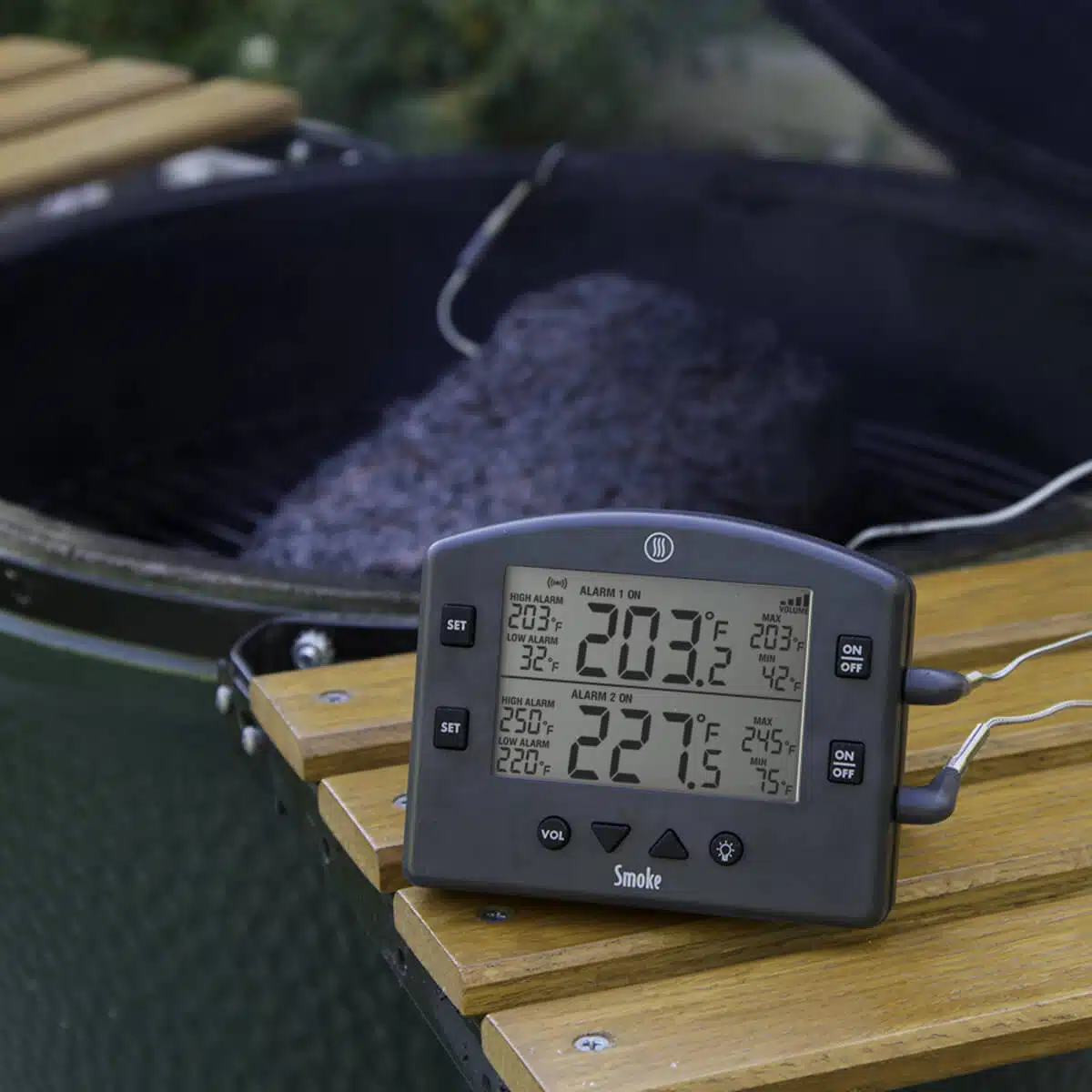
Pans with handles that clip on and off
They’re a product from Tefal that I picked up several years ago in France before I got into the Big Green Egg as they were perfect for the camper van. They’re called Tefal Ingenio and are available in the UK now from Amazon.
The handle clips on and off easily so you pop the pan in the Egg and take the handle off. I use mine all the time. They’re great for cooking tarte tatin.
Just be careful with non stick ones that you don’t get them too hot as the non-stick will start to break down.
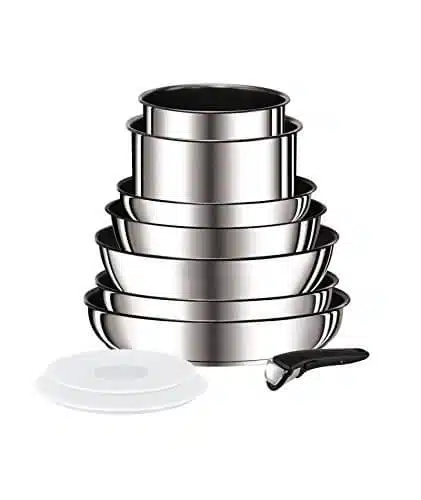
Witloft Leather Apron
My leather apron was from Witloft. I imported mine from the Netherlands but they now have UK dealers. Borough Kitchens sell them and they have shops in Chiswick, Borough Market and Hampstead.
I’m about to set myself up as a dealer I hope.
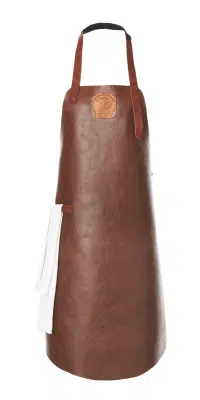
Pro Q Cold Smoke Generator
If you ever fancied getting into making you own bacon or smoked salmon then buy one of these. They’re as cheap as chips and superb. I use mine all the time, we’ve always got home made bacon and smoked salmon in the fridge.
Recommended Cook Books
Meathead
This is by Meathead Goldwyn, the man behind the AmazingRibs.com website. It’s got some really good stuff on technique as a well as some good recipes. It’s available on Amazon.
Food DIY
Tim Hayward is a Cambridge based food writer, restauranteur and chef. He’s judged on the BBQ scene. His book contain loads of great curing recipes as well as BBQ stuff. I really love it and use the recipes all the time. It’s available on Amazon.
